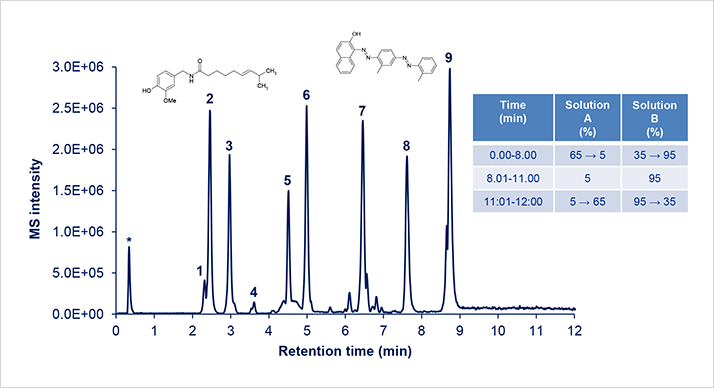Introduction
• Products containing chili or tomato are often colored to increase the attractiveness (e.g., of hot sauces, pesto, chili powder, curcuma and herb mixtures). Colorants used can be carcinogenic azo dyes such as Sudan or Para Red banned in the EU.• Monolithic silica capillary HPLC columns offer high sensitivity analysis and low LOD at overall low backpressure (as compared to particle packed columns). Due to the rigidity and robustness of the column bed no tedious sample preparation is necessary and clogging is minimized.


Chromatographic Conditions
Column Chromolith® FastGradient RP-18 endcapped 50-2mm Injection volume 2 μL System Bruker Esquire 3000plus ion trap Detection pos. ESI-MS (m/z range 100-700), BPC Flow Rate 0.4 mL/min Mobile Phase A: Water + 0.1% formic acidB: Acetonitrile + 0.1% formic acid Gradient See table. Temperature 25 °C Sample diluent (v/v) Acetonitrile Sample/sample preparation Approx. 10 g of a hot chili sauce were Soxhlet extracted during six hours using ethanol. The extract was filtered using a syringe filter (0.45 μm pore diameter) and diluted 1:1000 with ACN/water 50/50 (v/v). A colorant stock solution was prepared by dissolving approx. 10 mg of Para Red, Sudan I, Sudan II, Sudan III and Sudan IV in 100 mL ACN and combining aliquots. 3 mL of sauce extract were then mixed with 1 mL of colorant stock solution and made up to 13 mL with ACN. Concentrations of the colorants in the final mixture were: Sudan I 1.80 ng/mL, Sudan II 2.55 ng/mL, Sudan III 1.54 ng/mL, Sudan IV 1.49 ng/mL, Para Red 1.50 ng/mL. Pressure drop 45 – 17 bar
Ordering information
- Chromolith® FastGradient RP-18 endcapped 50-2 mm (Cat. No. 152007)
- Acetonitrile hypergrade for LC-MS LiChrosolv® (Cat. No. 100029)
- Water for chromatography LiChrosolv® (LC-MS) (Cat. No. 115333 or Milli-Q® water from water purification systems)
- Formic acid 98-100% for analysis EMSURE® (Cat. No. 100264)
- Millex syringe filter driven unit PTFE (Cat. No. SLCR025NS)





